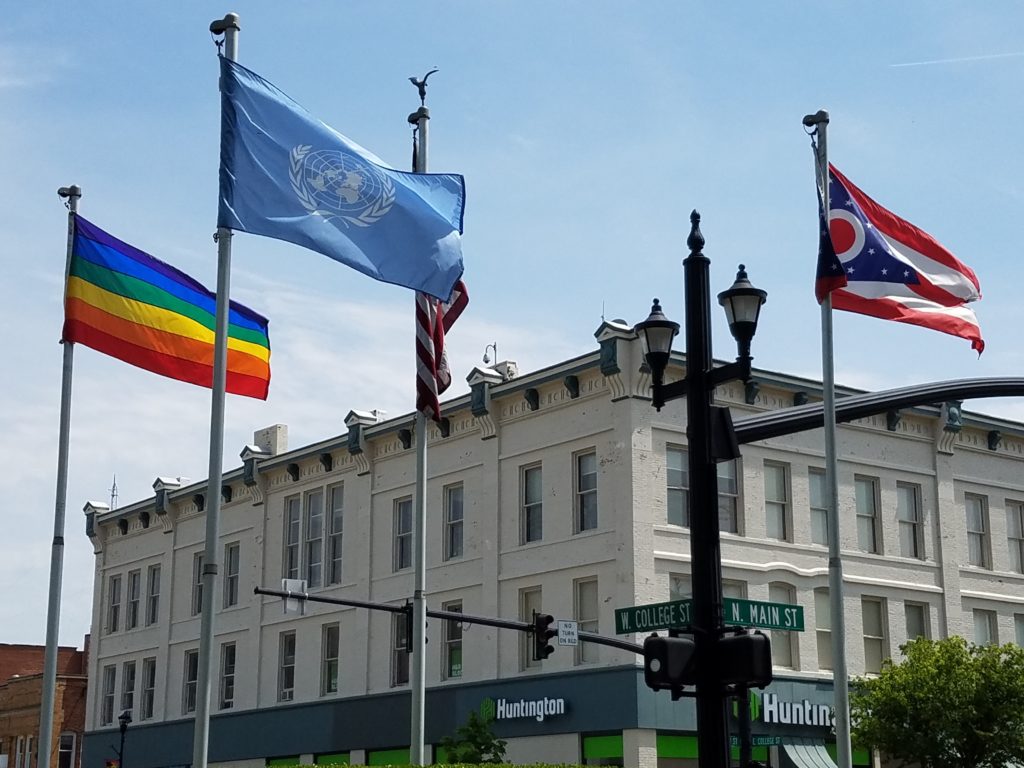Last week I briefly visited famed Oberlin College in Ohio, founded in the evangelical fervor of the Second Great Awakening, and closely associated with evangelist Charles Finney, who was its second president. In recent decades Oberlin’s religious heritage has been overshadowed by its progressive politics and role as frequent host to radical causes.
The campus corner touching the town’s main intersection features four flags illustrating the school’s current social perspective: Old Glory, the Ohio state flag, the rainbow flag and the blue United Nations flag. Across the street is the college’s new environmentally friendly hotel, the first in America heated and cooled geothermally, and where I enjoyed overnight hospitality.
Oberlin, founded in 1833, was one of the the first American colleges to host black students and women students along with its male students. It was from the start active in social reform, including abolitionism and universal education. It retained its Christian association into the early 20th century. A large monument on campus honors 15 Oberlin missionaries murdered in the Boxer Rebellion.
Historic First Congregational Church, now part of the United Church of Christ, abuts the campus. Finney, although Presbyterian, pastored there. A sign proudly notes speakers there have included Woodrow Wilson, Frederick Douglass, Mark Twain, Martin Luther King Jr, and Angela Davis, onetime Communist Party USA vice presidential candidate. A large pro-immigration banner adorns the church.
Finney was ecumenical and rejected aspects of traditional Calvinism. He was pragmatic in his revivalistic techniques, criticized then and now for purportedly trying to achieve conversions through human effort rather than strict reliance on the Holy Spirit. And he was a strong advocate for social reform. His critics would see a straight line between him and Oberlin’s secular leftist identity today.
This critique is not entirely fair. But to the extent it is valid, the progression is not unique to Finney but is true for Protestantism as a whole. By dethroning ecclesial obedience in favor of private conscience, and by asserting the priesthood of all believers, Protestantism helped create the modern secular age and its hyper stress on human equality. This revolutionary mindset leaves little room for tradition and hierarchy. Instead, all is new and egalitarian.
The four flags on campus signify this egalitarian universalist attitude that has little patience for old loyalties and particular covenants. The rainbow flag celebrates liberation from the constraints of traditional marriage, family and biological gender. The United Nations flag signifies a subordination of national priorities to globalism. There is no representation in this flag display of Christianity, despite its central role in founding Oberlin. Fidelity to a particular faith demanding comprehensive allegiance contravenes Oberlin’s modern preference for an all encompassing spirituality.
This universalist egalitarian perspective mitigates against traditional human community in favor of empowered autonomous individuals who preeminently define themselves. Such self-power against external authority is supposed to be liberating of course. But ultimately it can be isolating and lonely. Community in this perspective is at best conditional and can only be found through the constantly shifting tides of identity politics, which offer no organic permanence, and often depend on grievance.
The Protestant sociological journey need not conclude with such sterile isolation. But it has, for all its gifts to human uplift and equality, unintentionally contributed to modern Western culture’s deification of the self. In witness to this loneliness, at least at Oberlin, is the monument to the Boxer Rebellion’s martyrs, who were husbands, wives and children who sacrificed themselves in a distant land in fidelity to an eternal community. Their witness will prevail.





Comment by Quartermaster on July 29, 2017 at 9:28 pm
The legacy of Oberlin is fading into the past. The Seminary was sold to Vanderbilt in ’66, IIRC, and the faculty and student body go out of their way to show their SJW inclinations. Oberlin has gone the way of Yale and Harvard, on the road to perdition.